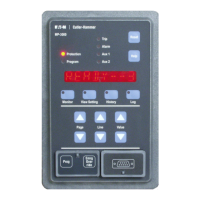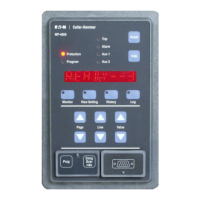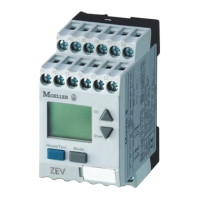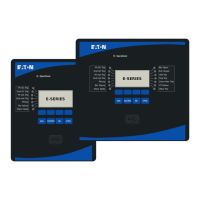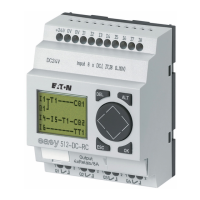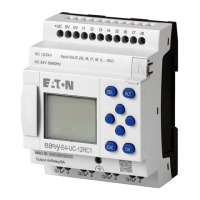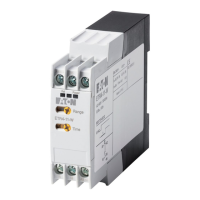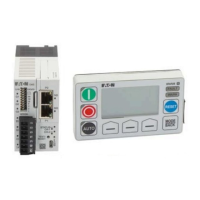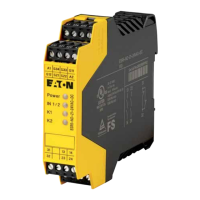For more information visit: www.cutler-hammer.eaton.com
Page 9-5
Effective 10/02 IL17562BH04
If there is no transition trip, and the relay declares a successful
transition, the display and data communications messages say RUN.
If P10L1 is set to TRN ON, the AUX 2 output relay will operate its
contact when the transition is declared. This contact controls a
reduced-voltage starter, switching to full running voltage.
Even if the transition control output contact is not used, set the
transition function to provide clear indications of the actual state of the
motor (START versus RUN) on the front-panel display and via data
communications. A good way to do this is to use the settings of P5L7
= TRN T+C and P5L5 = 130% of FLA. Modify the latter, if needed, to
lie at a transition value between the starting current and post-start
maximum load current. Set transition timer well beyond normal start
time to avoid a transition trip.
9.2.2 Start Delays
When the MP-3000 declares a START, all start timers of enabled
functions begin to time. Each of these timers blocks the respective
function until the set delay expires. These start timers don’t care about
transition—they run for the set time, which may be less than or greater
than the time of transition. These timers include:
• Ground fault start delay (GFSD, P3L2)
• Instantaneous overcurrent start delay (IOCSD, P3L5)
• Jam trip and alarm start delay (JMSD, P3L7)
• Underload trip and alarm start delay (ULSD, P3L10)
• Unbalance trip and alarm start delay (UBSD, P3L13)
Also, at the time of the start, the counters and timers for the jogging
controls are updated. These include starts allowed per time (ST/T and
T/ST, P5L1 and P5L2), time between starts (TBS, P5L3), and number of
cold starts allowed (NOCS, P5L4). If a jogging limit is reached, only a
STEX alarm occurs, but if the limit still applies when the motor next
stops then the motor is tripped and blocked at that time.
9.2.3 Run Cycle
Once the transition occurs, the MP-3000 declares the run state for the
motor; a RUN message is displayed and communicated to the
PowerNet host.
9.2.4 Run Delays
Note that run delays on trip and alarm functions don’t have any
particular relationship to the transition to the RUN state of the relay.
Run delays are pickup delays on active functions, which are able to
measure as soon as the respective start delay has expired—see 9.2.2
just above. The primary function of run or pickup delays is to prevent
nuisance tripping. These delays are:
• Ground fault run delay (GFRD, P3L3).
• Jam trip run delay (JMTR, P3L8).
• Underload run delay (ULTR, P3L11).
• Phase unbalance alarm run delay (UBTR, P3L14).
• Jam alarm run delay (JMAR, P4L4)
• Underload alarm run delay (ULAR, P4L6)
• Unbalance alarm run delay (UBAR, P4L8)
• Load shed delay for pickup and dropout (LSDL, P9L3)
9.2.5 Stop Cycle
The run cycle continues until the motor current level falls below the
Stop Current Threshold (STOP XX, P1L9) setting current on all three
phases. Then, a stop is declared. Jogging limits, as listed in 9.2.2
above plus antibackspin time delay (ABKS, P5L12) are checked and if
required, the MP-3000 trips with the appropriate display message(s).
Remaining jogging block times are displayed and counted down,
telling the user how long to wait. If there are no such starting block
conditions in effect, the MP-3000 closes (or never opens) the trip
contact and displays READY —3.
9.2.6 Trips and Trip Bypass
If any of the motor protective functions operate while the motor starts
or runs, the MP-3000 opens its trip contact and displays the cause(s)
of the trip. It may also open its trip contact after a stop is recognized if
any jogging function time limit is blocking the next start. In either case,
the MP-3000 expects that the contactor is then open in response and
that no current flows.
If the MP-3000 sees noticeable current for more than about a second
whenever it is tripped, it declares a trip bypass and a message is
displayed. This means that the relay blocking of the contactor has
been circumvented by the user to start the motor. If the current fails to
stop when the MP-3000 trips a running motor, it may be because of a
user trip bypass, or because of a stuck contactor.
Consider the possibility of backup protection for a contactor opening
failure. Configure the AUX1 or AUX2 output relay to pick up for a trip
bypass. Connect the contact to trip an upstream breaker. This will
protect the motor from damage in case of a stuck contactor (at the
cost of interrupting other loads connected to the same breaker).
9.2.7 Armed/Disarmed Mode
If the MP-3000 is DISARMED (P12L18), trip messages are displayed
but the trip relay will not be operated. This is useful in a critical
process, if it is imperative to keep the motor running while settings are
changed or the relay is replaced. Commission the new relay or
settings in the DISARMED state. Make sure the relay is also set for
RUN PGM (P12L6) before commissioning. Watch for any trip mes-
sages and observe the contents of the thermal bucket for a while.
When it is apparent that the relay behavior is secure and stable,
change P12L18 to ARMED.
9.3 Ac Line Interruptions
The MP-3000 has an exceptional ability to ride through voltage sags
and interruptions, even longer than a delayed-dropout contactor it
controls. With this capability, most users can avoid the addition of a dc
battery supply or an uninterruptable power supply (UPS).
The relay will operate continuously for ac supply voltages down to 55%
of rated value (66 Vac for a 120 Vac supply system; 132 Vac for a 240
Vac supply).
For a complete supply interruption, the nominal ride-through rating is
30 cycles. The relay will typically continue to operate for 25 to 50
power cycles, depending on power supply loading variables:
• Number of output relays picked up.
• Current being delivered by the 4-20 mA analog transducer output
port.
• Type of PONI communications module powered by the MP-3000, if
any.
• Electrical URTD communications (using recommended optical
communications lowers this burden slightly).
The one load which may depress the MP-3000 ride-through times well
below 25 cycles is the use of a Cutler-Hammer Ethernet PONI (EPONI)
for communications – particularly the EPONI with optical fiber
communications. In this case, ride-through could fall to 10-13 cycles.
However, this is easily remedied by powering the EPONI from its own
optional external power transformer. Then, the MP-3000 ride-through
will return to its 30 to 50 cycle range.
